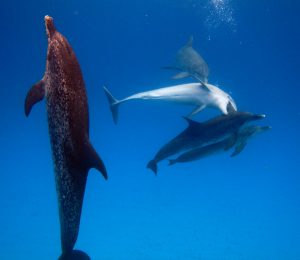
On Wednesday, we woke up to the pitter patter of raindrops and wondered what the day would bring. Kel walked in wearing her bathing suit, so our optimism returned. Ignoring the weather, we focused on our class discussion about interspecies interactions, specifically between bottlenose and Atlantic spotted dolphins. We discussed different species in an aggregation versus actually interacting. As we talked through the Bimini specific research, we saw that many of the mixed species interactions include some sort of “mating.” Because this mating can include non-reproductive pairs, it gives us insight into mating as a socio-sexual behavior in dolphins. We discussed the importance of assessing sexual interactions without using emotional human terms. We saw a short video of past observations here in Bimini and saw the challenges: it is hard to actually see what is going on! Though there is a wide angle view, it is not 360, so you cannot use your peripheral vision to assess what other members of the group were doing. That’s on top of the ordinary challenges of water clarity, distinguishing species and age classes and the distance the dolphins to the camera.
After lunch (yummy, rainy day chicken noodle soup!), we visited the straw market for an internet check and some shopping. Win-Win. Then, we got the go-ahead for the boat trip! Cloudy skies weren’t going to keep us at the dock. The trip was uneventful at the beginning and very overcast. Our hopes were tempered since we knew the lack of sunlight would make it more challenging to spot the dolphins. Plus, there was a larger swell, but thankfully the wind driven waves were minor. Before 1700, Dr. Yeater saw major splashing and a tail fluke – the dolphins weren’t far off, but what were they doing?! We were all pretty excited, especially as Captain Al called out that it was a mixed species group, even as we were trying to figure it out. Did the dolphins know we had just discussed this?! We observed from the boat for a bit as they were very active at the surface. We saw some spyhopping as the dolphins rubbed up against each other. We were able to use our study of the DCP ethogram for lots of new behaviors, including socio-sexual behaviors. It was a pile of dolphins though, making it hard to get a good group count. We noticed difference between the bottlenose dorsal fins and could tell there were different age classes of spotteds. Soon, it was time to get in the water and we forgot all about the chilly, cloudy day…
In the water, we were finally able to get a group count. There were 11-12 dolphins in total, but we’ll need to review the data to be sure. The water was nice and clear, which along with the distinctness of the dolphins, helped make it easy to tell the species apart. There were four bottlenose dolphins, including a younger one with a smaller, yet intact, right pectoral fin. Two of the bottlenose dolphins, and some of the spotteds, did not stick around, but we were able to spend over 40 minutes with a group of six: two bottlenose and four spotteds. In the moment, we were able to identify Split Jaw (#22) and Prince William (#64)! Kel is so proud of us! With everyone’s help, we confirmed that all six dolphins in the group were males, making it particularly interesting to us that sexual behavior dominated the interactions. The spotteds seemed more likely to take a break and come investigate/interact with us. The bottlenose were much more likely to stay with the dolphin group, or take short breaks from the spotteds but stay as a pair. They tired us out, so when they started keeping their distance, we returned to the boat. We all tried to warm up and recharge with snacks, chatting about the cool interactions we had just observed!
Back on land, we cleaned up and had another group BBQ. Back in our common room, happy that the Stanley Cup was on (Canadian TV in Bimini!), some of us got a jump start on ID’ing the day’s photos.
Until tomorrow,
The PEDuncadunks
